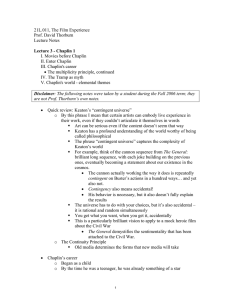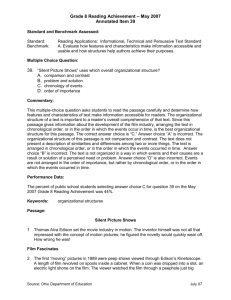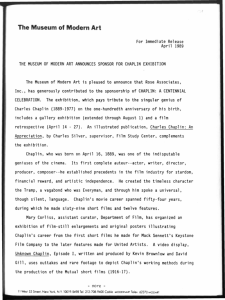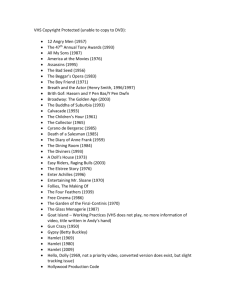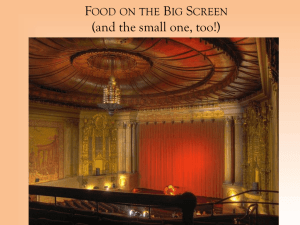21L.011, The Film Experience Prof. David Thorburn Lecture Notes Week 3: Evening Lecture
advertisement
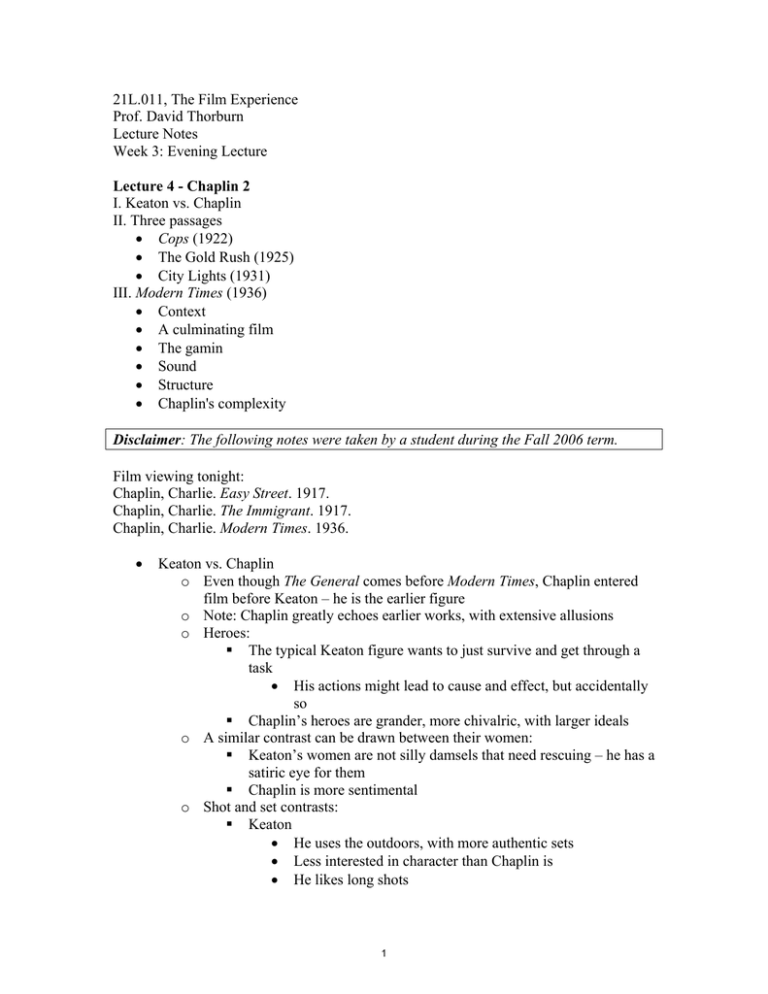
21L.011, The Film Experience Prof. David Thorburn Lecture Notes Week 3: Evening Lecture Lecture 4 - Chaplin 2 I. Keaton vs. Chaplin II. Three passages Cops (1922) The Gold Rush (1925) City Lights (1931) III. Modern Times (1936) Context A culminating film The gamin Sound Structure Chaplin's complexity Disclaimer: The following notes were taken by a student during the Fall 2006 term. Film viewing tonight: Chaplin, Charlie. Easy Street. 1917. Chaplin, Charlie. The Immigrant. 1917. Chaplin, Charlie. Modern Times. 1936. Keaton vs. Chaplin o Even though The General comes before Modern Times, Chaplin entered film before Keaton – he is the earlier figure o Note: Chaplin greatly echoes earlier works, with extensive allusions o Heroes: The typical Keaton figure wants to just survive and get through a task His actions might lead to cause and effect, but accidentally so Chaplin’s heroes are grander, more chivalric, with larger ideals o A similar contrast can be drawn between their women: Keaton’s women are not silly damsels that need rescuing – he has a satiric eye for them Chaplin is more sentimental o Shot and set contrasts: Keaton He uses the outdoors, with more authentic sets Less interested in character than Chaplin is He likes long shots 1 Keaton calls attention to the presence of the camera, and the way that it alters things, thus interrupting reality He even calls attention to the flat frame of the screen, and how it interferes with perspective o (Think of the beginning of Cops, where he tricks you into thinking that the character is in jail – a highly cinematic joke) Chaplin He is much more social and psychological in his interests o Physical objects and materials In The General, we see every physical aspect and corner of the train, all over. The character’s relation to that huge physical object is very intimate. It is a key aspect of Keaton that he pays so much attention to these huge objects In Chaplin, the objects are much smaller and more manageable – but his relation to them is enormously imaginative and transformative Example: showing a rotten old shoe into a Thanksgiving dinner Also note what he does with his cane and his hat With these objects Chaplin’s films emphasize psychology. The Tramp as myth o Anthropologists would say that myth is communally created, and while the Tramp does have an inventory – Chaplin – he also has a sort of communal evolution o Clip: an early Keystone comedy The Keystone company (which Chaplin worked for first) created the first comedy films These sorts of films built into a sort of comic frenzy – chaos, cheap jokes; they didn’t really have a coherent story Unlike these films, Chaplin was the first to introduce character and personality to comedy films Chaplin’s films were slower, but also funnier Keaton’s jokes, on the other hand, have the aura of randomness and chaos, but they are actually highly complex, planned-out jokes The universe doesn’t notice or care about us – we are insignificant specks Similarly, there are the opposite jokes, when a character narrowly avoids catastrophe and doesn’t notice o In entertainment, single events or aspects of a work have single purposes (exposition, humor, etc.). In art, they have many purposes all at once. This is the multiplicity principle. Chaplin’s jokes not only are funny, not only develop character, but also are complex social and political jabs. 2 o The Tramp was widely recognized in American and British culture almost immediately and almost instantly o He sparked a huge number of imitators o The various highly imaginative ways he uses his cane tell us something about his relation to objects o He had such a universally recognized, insuppressible, versatile figure, and this is why he recalls elements of myth o The Tramp was originally a much more anarchic, controversial figure, but Chaplin quieted the character down somewhat as he became more popular Something very similar actually happened to Mickey Mouse o Chaplin actually lived homeless for much of his childhood, when his mother was institutionalized, motivating political jabs o Chaplin is both political and sentimental o When IBM first marketed PCs broadly, they used a figure of Chaplin as the Tramp from Modern Times in their commercials o The Tramp is so well known and incorporated into society, that Chaplin doesn’t own him anymore, society does. o He motivates an aura of mythic significance o His main themes in all his movies are elemental – they’re very basic to human existence – and they tend to be fundamentally unfunny at their core: violence, hunger, danger, humiliation, powerlessness He’s able to convey highly complex elemental emotions in tiny gestures and facial expressions It’s as if he’s telling the same jokes over and over again, but you don’t get tired of it – you’re probably even surprised Modern Times o Modern Times is not only one of the best films of the silent era, but it’s one of the 10 or 15 best films ever made. o Chaplin was the first to discover that you can mix drama and comedy o After he created the Tramp in 1915, there are always unfunny, serious, dramatic scenes in Chaplin’s films o One of the main ways he did this is by mastering the face – he really mastered the close-up in a way nobody had done before o He created comedic melodramas (where melodrama is used as a neutral, nonnegative term) o Note: The female character in Modern Times is the first in his films ever to stand up to him, as an equal, as multidimensional, as having her own independent emotional life. o Clip: from City Lights o Modern Times is a culminating film, in much the same way as The General He made this film 8-10 years after sound had already been introduced It’s not technically silent, because it has a soundtrack, but characters only speak when they’re mediated by machines 3 o o o o The role of sound is very interesting Modern Times was a nostalgic culmination of the silent era It was advertised as the Tramp’s final farewell He has a whole series of jobs, which systematically invoke his older films – virtually every scene has a counterpart from earlier in his career, which the audience would have recognized Context: the 1930s Modern Times is about the depression, strikes, labor and capital, class inequalities. It’s not a Marxist film, but it is an angry and radical one. Chaplin is just as critical of labor as he is of industry The soundtrack is rich and interesting Drawn from tunes of the 1920s and earlier Certain themes are invoked for particular characters The tune connected to the Tramp would have been recognized by the audience, and it has lyrics, which are about a hobo/tramp Speech is mediated through mechanization He uses the music to express the psychological state of the characters – example: listen to the music during the scene where the Tramp skates on the edge of a precipice Character: altered states Whenever the Tramp acts with great heroism, it’s when he’s in an altered state It might be part of his heroic nature, but it’s also outside himself Structure: plot as meaning equals organic form. Rhyming scenes: repetition. The film is truly episodic, and the scenes of part II echo and reflect upon the scenes of part I. The center pivot point of the movie is the department store scene. This structure evolves because the film is telling the story of Charlie’s/the Tramp’s life. The structure repeats because the Tramp never really gets anywhere – his life is stuck on a treadmill. The form is organic because it’s natural to and enacts the themes of what the work means. This is the principle of organic form. 4 MIT OpenCourseWare http://ocw.mit.edu 21L.011 The Film Experience Fall 2012 For information about citing these materials or our Terms of Use, visit: http://ocw.mit.edu/terms.
